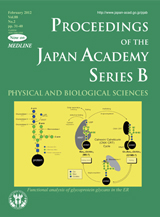About the Cover
Vol. 88 No. 2 (2012)
The endoplasmic reticulum (ER) plays central roles both in synthesizing of glycoproteins and in regulating their folding process. In the ER, cooperative action of chaperones, enzymes, and cargo receptors constitutes a “quality control” system which assists in glycoprotein folding and discriminates misfolded and correctly folded glycoproteins. Initial modification of proteins by Asn-linked glycan is made by the introduction of high-mannose type tetradecasaccharide consisting of three D-glucose (Glc), nine D-mannose (Man) and two N-acetyl-D-glucosamine (GlcNAc) residues. Subsequent processing by glusosidases are delivered to the calnexin/calreticulin (CNX/CRT) cycle. The association of CNX/CRT with the glycoproteins is regulated by ER glucosidase II, which hydrolyzes Glc2Man9GlcNAc2 glycans to Glc1Man9GlcNAc2 and further to Man9GlcNAc2, whilst ER mannosidase I removes one or more Man residue(s) from the latter. On the other hand, the opposite activity of UDP-Glc: glycoprotein glucosyltransferase (UGGT) converts ManXGlcNAc2 (X=7~9) back to Glc1ManXGlcNAc2 when protein folding is incomplete.
Glycoprotein quality control is modulated by fine specificities of these enzymes and chaperones, which are believed to recognize similar but distinct glycans. However, evaluation of their precise specificities has been hampered by structural heterogeneity of natural glycoproteins. On the other hand, the strength of chemical synthesis is clear, because of its ability to unambiguously provide natural as well as non-natural glycans. However, preparation of biologically relevant glycans consisting of >10 sugar residues is challenging. Dr. Ito’s group has achieved comprehensive synthesis of high-mannose-type glycans and their derivatives. With these probes in hand, they have clarified specificity of various proteins involved in the glycoprotein quality control system, especially CRT, G-II and UGGT, in a quantitative manner.
Their work summarized in the article published in this issue (pp.31- 40) clearly shows the utility of synthetic chemistry in drawing fine pictures of biological functions of glycoprotein glycans.
Director, Wako Institute, Riken




